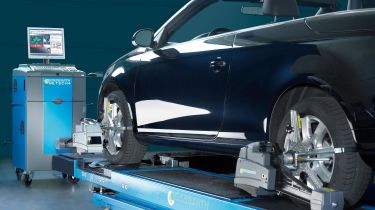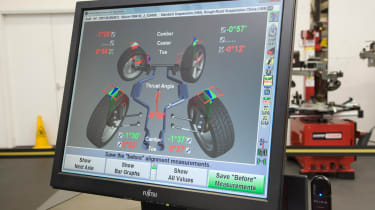Laser wheel alignment explained
If you notice a difference in the way your car drives, laser wheel alignment could hold the solution

We’ve grown used to cars being tough, sturdy and reliable but wheels are still sensitive and vulnerable to things like potholes and kerbs.
If you’ve hit a kerb, you may notice how the car pulls slightly in one direction or the steering wheel doesn't look quite centralised in the straight-ahead position. It probably means your front wheels are not aligned correctly. It’s time to have them checked and, if necessary, corrected using laser wheel alignment.
What is laser wheel alignment?
It sounds complicated but it’s simply a way of using light beams to check your car’s front wheels are set up as they should be. You’d think this means simply pointing forwards but in fact, wheels are set up to point at specific angles to ensure the car rolls along smoothly.
To check the alignment, a technician attaches brackets to your car’s wheels and shines a light from one to the other or, using an overhead projector, to all four. Depending where the beams of light fall on a scale, the technician can see whether the wheels are in or out of alignment.
For greater accuracy, a computer is used to check the position of the light in relation to the scales. Once the degree of misalignment has been established, it’s a relatively simple job to adjust the suspension so the wheels are set up correctly once more.

What does laser wheel alignment check?
Three angles of wheel alignment are checked, called camber, caster and toe. Each has a different angle calculated by the car maker to improve the performance of the car’s steering and suspension systems with the goal of making the car handle smoothly, responsively and predictably.
Camber: This is a measure of how vertical a tyre is. If it’s set so that it leans slightly towards the wheelarch it’s described as having negative camber. In the other direction, it’s called positive camber.
Caster: this is slightly harder to visualise, but concerns how directly above the wheel’s centre the suspension sits and, therefore, how central the angle of the tyre’s placement on the road is on the front to back plane. If you think of a ‘chopper’ style motorcycle with its suspension steeply raked back, this would be an example of extremely positive castor.

Toe: wheels that point inwards at the front towards the centre of the car are experiencing toe-in, while if the front of the wheels point outwards towards the road, this is toe-out.
These may sound like similar terms, so you may find it easier to look at your feet for an explanation: if you point your left and right big toes close to each other so your feet make a ‘V’ shape, this is toe in – splay the front of your feet outwards in the opposite manner and this is toe out. If you rock your feet on their inside and outside edges you’d be adjusting their camber, while if you lift the toes or the heel up in the air slightly, you’d be changing caster.
How can I tell if my wheels need alignment?
The most obvious symptoms of misaligned wheels are:
The car pulls to left or right when the steering wheel is straightUneven tyre wearJuddering through the steering wheelThe steering wheel is off-centre when driving straight (although this can be due to an improperly installed steering wheel)
It’s worth noting that the shape of the road may pull your car to the left slightly, as the weight of vehicles travelling on it (and drainage requirements) mean most roads tilt away from the centre slightly. It’s also rumoured new cars are configured so if the driver isn’t holding onto the steering wheel (if they fall asleep, say) the car will drift to the side of the road very slightly, rather than into the path of oncoming traffic.
Either way, if you notice any significant changes to the criteria listed above, or if you just feel something is ‘not right’ with your car’s handling, it’s always advisable to get the wheel alignment checked out.
Why do wheels become misaligned?
If you kerb the wheels when parking or drive over a pronounced pothole, this is sometimes enough to knock the wheels out of alignment. Wear to steering and suspension components can also cause problems.
It’s also a good idea to get the wheel alignment of a new car inspected after the first few thousand miles, because the suspension may ‘bed in’ as the car is driven, becoming slightly out of alignment in the process.
If you find your car needs its wheels aligning frequently, or, if even after they’ve been checked the car still exhibits the symptoms listed above, it could be there are worn suspension or steering parts in need of replacement.
How much does laser wheel alignment cost?
Not much, and getting it done can transform the way your car drives. Most garages charge between £25-£65 for wheel alignment, depending on whether they check just the front wheels or all four and how sophisticated the checks they do are. It’s generally a good idea to get all four wheels done, as the front and backs can be perfectly set up in conjunction with each other, and according to manufacturer guidelines.
What’s the difference between tracking and laser alignment?
Depends who you ask. Some people use the terms synonymously, while others hold laser wheel alignment is a more sophisticated process. A simple tracking check tends to cover only look at certain elements of the front wheels, while laser alignment will generally measure more points and angles on all four wheels.
Most Popular

New Smart #5 Brabus is a 637bhp far cry from the brand’s city car past

Best car leasing deals 2025: this week’s top PCH offers
Tips & advice

Car dashboard warning lights: what does each symbol mean?

Electric car charging stations: public networks, charger types, apps and maps







